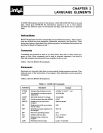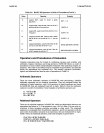
Language Elements
2-6
Constants
Constants are numeric values that do not change during program execution. A con-
stant can be a decimal integer, hexadecimal integer, octal integer, single-precision
floating-point number, or double-precision floating-point number.
Table
2-5.
Numeric
Data
Types
Numeric
Type
Range
Storage
Definition
Suffix
Examples
Required
Integer
(decimal)
-32768
to
2 bytes
DEFINT % X%
+32767
9463%
Integer
(hexadecimal)
Oto
2 bytes -
H
OFF4H
FFFFH
Integer
(octal)
Oto
2
bytes
-
0
7720
1777770
Single-precision
floating-point
±1.2 x
10-
38
to
4
bytes
DEFSNG
!
X!
(7
digits
precision)
±
3.4
x
10
38
9436.5!
9.4365E03
Double-precision floating-point
±
2.2
x 10-
308
to
8 bytes DEFDBL
#
X#
(16
digits
precision)
± 1.8 x
10
308
9436.5#
9.4365D03
Integer Constants
Integer constants are whole numbers in the range
-32768
to 32767. Each integer
constant requires two bytes
of
memory. Because the storage requirements are lowest
for integers and integer arithmetic
is
much faster than floating-point arithmetic, it's
a good idea to use integer representation wherever possible.
Decimal Integer Constants
To identify a constant as a decimal integer constant, add the suffix
070
to the decimal
integer value.
Some decimal integer constants are:
Hexadecimal Integer Constants
Hexadecimal integer constants are identified by the suffix H following the numeric
value. The characters
0-9 and A-F (representing the decimal values
10-15)
are used as
hexadecimal digits. Each character represents 4 bits
of
data. The first character must
be a decimal digit, so
it
may be necessary to
add
a leading
o.
Some hexadecimal in-
teger constants are:
Hexadecimal
1FH
OC76H
7H
Decimal
Equivalent
31
3190
7
BASIC-80


















